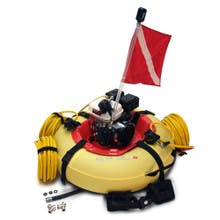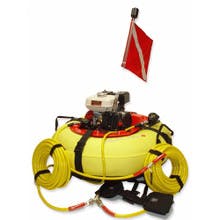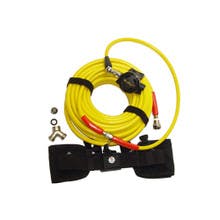What is Hookah Diving?
Hookah diving, also referred to as Tankless Diving, consists of a battery or gas-powered air compressor that delivers air through a long hose called a down-line, to the diver via a low-pressure regulator. It can run for 3 to 3.5 hours and supply air to more than one diver at a time (depending on the system). Hookah diving is often done in less than 40 feet of water; however some systems are designed to work well down to 65 feet. For many, the name "hookah" conjures a tall, multi-hosed tobacco pipe out of the Arabian Nights. That's probably the reason people are now referring to surface supplied air diving as Tankless Diving. Note that we’re using both terms herein.
Hookah diving is different than your traditional scuba gear. It does not require the use of a BCD or a first-stage regulator. Divers wear a weight belt, which is the attachment point for the down-line and optional weights. Divers use a low-pressure second-stage regulator that's specifically designed for use with a tankless diving system. A traditional scuba regulator will not work because it’s set up to handle high pressure.
Though the personal gear requirements of hookah diving are minimal, when you purchase a tankless diving system, you are required to have a scuba certification. The reason is simple: all the safety precautions that apply to scuba diving also apply to hookah diving. You need to learn and understand things like decompression stops, how to use compressed air and dive computers, and other safety factors. Decompression sickness (DCS), commonly called "the bends”, happens when a diver comes to the surface too quickly. It's a serious health and safety issue and can happen with hookah diving.
Benefits of Hookah Dive Systems
- No heavy tanks to carry
- No straying away since you're tethered to the tankless system
- Multiple divers can use one system
- Stay underwater longer and dive deeper than snorkeling
- Less expensive than traditional scuba gear
- Floating platform on the surface alerts other boaters to your whereabouts underwater
Types of Hookah Dive Systems
There are two types of hookah dive systems: dynamic and static. A dynamic system uses an air compressor to deliver air at the correct pressure. It has a holding tank that provides constant pressure. As the air leaves the tank, more air is added to maintain the pressure. The compressor can be floating or fixed and gas or electric. A static system uses a cylinder of compressed gas (often a scuba tank) as the air source.
A fixed compressor is placed on a dock or on a boat while in use. Some boats have outlets for hookah down lines. Floating means that the air source is on a floating platform that the diver pulls along with them. This is the most common type. Brownie's Third Lung is a popular brand and is the one most often seen in use.
Gas VS Electric Tankless/Hookah Dive Systems
Hookah systems are available in both gas and electric versions. You can get about three hours of dive time on 2.5 quarts of gas, which is less expensive than filling a scuba tank. Gas systems do require more maintenance than electric versions. They're also a bit louder.
The more "green" electric systems require less maintenance than gas systems. They can be recharged on the boat, are quiet, easy to start, and less prone to corrosion. Electric tankless diving rigs are very popular among eco-tourists in the Caribbean and the South Pacific islands.
Uses for a Tankless Dive System
- Enjoy deeper dives without the cumbersome scuba gear
- Get up close to sea life and coral formations for underwater photography and videography
- Stay underwater till you catch your lobster bag limit
- Provide inspection and maintenance on boats and docks
Components of a Tankless Diving System
Tankless diving doesn't require quite as much equipment as traditional scuba diving. There are five main pieces of gear included in most hookah diving systems. Basically, all you need to add is a mask and fins - the hookah dive kit takes care of the rest.
Air Compressor – Tankless divers don't use air tanks on their backs like scuba divers. Air is delivered to them by an air compressor that's located on the boat or floating platform. It has a rubber diaphragm or a piston and operates at low pressure ("low pressure" compared to the 3000+ psi of a scuba diving cylinder). A pressure relief valve provides safety measures to prevent pressure buildup. More air volume is provided when there are multiple divers.
Air Reserve Tank – The air reserve tank is a "reservoir" of sorts. It provides a constant volume of air at all times, as well as cooling and condensation. The air reserve tank cools hot air as it enters the tank. Condensation then occurs so that the diver doesn't breathe as much moisture. The air reserve tank also stops surges coming from the compressor. This gives an even flow of air. As an added safety feature, it contains enough pressurized air to give the diver a couple of minutes of air if the compressor runs out of air or there's engine failure.
Air Hose – The air hose, attached to the air compressor, is made out of food-grade vinyl, nylon webbing, and PVC that's oil, gas, and UV-resistant. It's usually in a bright color like yellow or orange so that it's visible above and below the surface. Kink, collapse, and abrasion-resistant, the air hose floats so that it doesn't entangle divers or underwater obstacles. As you might expect, one air hose supports one diver.
Regulator – The second stage regulator is how the diver gets air. It fits in the diver's mouth and regulates the amount of air received when he/she inhales. Tankless diving only uses a low pressure second-stage regulator. You can't just plug your favorite scuba regulator into a tankless system as most scuba regulators are set up to handle high pressure.
Harness – The harness is worn on the diver's waist and keeps the air hose out of your way. Also prevents the regulator from being pulled out of the diver's mouth (since the regulator hose attaches to the harness). Harnesses typically are integrated with a weight belt to counteract your body's natural buoyancy and make depth control easier.
Additional Tankless Diving Equipment You'll Need or Want
Whether you're searching for sea life, watching for wrecks or photographing coral formations, tankless diving offers freedom and ease into the underwater world.












